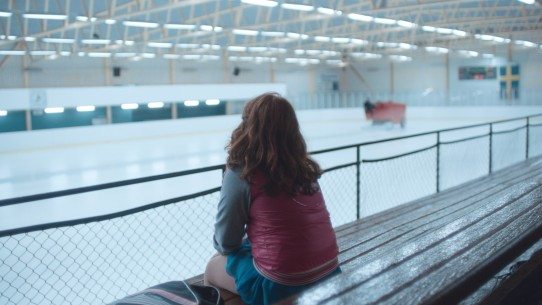Berlinale 2015: My Skinny Sister
Director: Sanna Lenken
Cast: Rebecka Josephson, Amy Daesismont, Annika Hallin
Length: 95 minutes
Country: Sweden
Like many younger siblings, Stella (Rebecka Josephson) idealises her elder sister Katja (Amy Daesismont). She’s beautiful and an expert figure skater, training for competition. However, Stella starts to notice things, things Katja’s trainer Jacob (Maxim Mehmet) and parents don’t notice; Katja appears to have lost her appetite. Stella’s suspicions are confirmed when she sees her throwing up in a restaurant bathroom. Stella wants to tell their mother, but Katja threatens her quite viciously. As Stella’s struggle to tell someone plays out, My Skinny Sister reveals itself to be a compelling drama about the nature of anorexia and the relationships between siblings.
It is an undeniable fact that women are under more pressure than men to conform to a certain body and social type. Film is the ultimate leveller and a great tool for interrogating these horrific structures in a humane, non-didactic way. Ice skating in the film is used as an example of the perfect female type – lithe, skinny, free-floating across the ice – reminiscent of how ballet is used in Black Swan. But as seen in Black Swan this type of physical perfection is an illusion, and only achieved through hard work and a rigorous dieting programme. My Skinny Sister questions the ethics of putting too much pressure on young girls during a time when they are likely to feel the most self-conscious. But whilst the film may implicitly suggest patriarchy is the problem – her trainer being a man, and her father at times shrugging off the issue – the film wisely never insists on it, not looking for who is to blame, instead analysing a myriad of causes in an intellectual and sympathetic manner.
My Skinny Sister questions the ethics of putting too much pressure on young girls during a time when they are likely to feel the most self-conscious.
The cinematography at times is akin to that in a horror film, with dark claustrophobic lighting and a muted colour palette. This interpretation is also invited when the family actually go to a cabin in the woods. This makes sense as mental illness is a horror for the person involved. “It’s all meaningless,” Katja moans repeatedly throughout the movie, unable to believe in herself. There are some scenes later on in the movie that are highly unpleasant, terrifying in their brutality – but they work well – effectively conveying the point of the film without ever seeming exploitative.
There is some needless filler in this film, which although is worked into the plot-line, such as Stella’s relationships with young boys and her burgeoning crush on Jacob, could have been handled a little more subtly. However, the film significantly increases in power as it progresses, and its overall message ends up being stronger than its slightly uneven plot.
My Skinny Sister’s greatest strength lies in its use of perspective. By limiting our view of Katja through her sister the film eschews simplistic explanations for her problem revealing that there is no one-size-fits-all solution to anorexia because the mental reasons differ with each case. The sense of pathos is also increased as we see how it affects not just the person involved, but fellow family members as well. If the film was primarily focused on Katja and her attempts to deceive her family it would risk losing its universal message and would instead become a singular character study. By viewing it through the prism of family the films impact hits much stronger, making it work both as satisfying drama and successfully raising awareness for the issue. Anorexia affects more young people than you would think, making this a must-see movie for all the family.
Image Source: berlinale.de


Comments (1)
I so totally understand why Amy Deasismont (not Daesismont) have been using Diamond as her artist name… 🙂